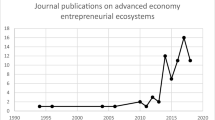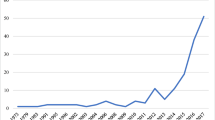Abstract
Previous scholarship in entrepreneurship and sport management has highlighted their symbiotic nature. The degree to which sport is embedded in society makes it an ideal platform from which to launch economically-motivated entrepreneurial endeavors that may also be leveraged to generate socially transformative causes. Despite this important realization, efforts to understand sport entrepreneurship have been limited in their ability to describe the broad trends affecting sport entrepreneurs. This study uses a sample of 967 sport-related transactions by private equity and venture capital firms between 1988 and 2016 to chart some of these trends. In doing so, we hope to provide a solid foundation on which future sport entrepreneurship research can build. The results accentuate some interesting paradoxes in how private equity and venture capitalist firms invest in and divest from sport-related entrepreneurial ventures.

Similar content being viewed by others
References
Akhtar, R., Ahmetoglu, G., & Chamorro-Premuzic, T. (2013). Greed is good? Assessing the relationship between entrepreneurship and subclinical psychopathy. Personality and Individual Differences, 54(3), 420–425. https://doi.org/10.1016/j.paid.2012.10.013.
Amason, A. C., & Sapienza, H. J. (1997). The effects of top management team size and interaction norms on cognitive and affective conflict. Journal of management, 23(4), 495-516.
Austin, J., Stevenson, H., & Wei-Skillern, J. (2006). Social and commercial entrepreneurship: Same, different, or both. Entrepreneurship Theory and Practice, 30(1), 1–22. https://doi.org/10.1111/j.1540-6520.2006.00107.x.
Ball, S. (2005). The importance of entrepreneurship to hospitality, leisure, sport and tourism. Hospitality Leisure Sport and Tourism Network, 1(1), 1–14.
Ballouli, K., & Hutchinson, M. (2012). Branding the elite professional athlete through use of new media and technology: An interview with ash de Walt. International Journal of Entrepreneurial Venturing, 4(1), 58–64. https://doi.org/10.1504/IJEV.2012.044818.
Barney, J. B. (1986). Strategic factor markets: Expectations, luck, and business strategy. Management Science, 32(10), 1231–1241. https://doi.org/10.1287/mnsc.32.10.1231.
Beutler, I. (2008). Sport serving development and peace: Achieving the goals of the United Nations through sport. Sport in Society, 11(4), 359–369. https://doi.org/10.1080/17430430802019227.
Bjärsholm, D. (2017). Sport and social entrepreneurship: A review of a concept in progress. Journal of Sport Management 31, 1–41.
Bull, I., & Winter, F. (1991). Community differences in business births and business growths. Journal of Business Venturing, 6(1), 29-43.
Burns, B. L., Barney, J. B., Angus, R. W., & Herrick, H. N. (2016). Enrolling stakeholders under conditions of risk and uncertainty. Strategic Entrepreneurship Journal, 10(1), 97–106. https://doi.org/10.1002/sej.1209.
Chalip, L., & Leyns, A. (2002). Local business leveraging of a sport event: Managing an event for economic benefit. Journal of Sport Management, 16(2), 132–158. https://doi.org/10.1123/jsm.16.2.132.
Chell, E. (2007). Social enterprise and entrepreneurship: Towards a convergent theory of the entrepreneurial process. International Small Business Journal, 25(1), 5–26. https://doi.org/10.1177/0266242607071779.
Chell, E., Spence, L. J., Perrini, F., & Harris, J. D. (2016). Social entrepreneurship and business ethics: Does social equal ethical? Journal of Business Ethics, 133(4), 619–625. https://doi.org/10.1007/s10551-014-2439-6.
Chrisman, J. J., Bauerschmidt, A., & Hofer, C. W. (1998). The determinants of new venture performance: An extended model. Entrepreneurship Theory and Practice, 23, 5-30.
Cousens, L., & Slack, T. (1996). Using sport sponsorship to penetrate local markets: The case of the fast food industry. Journal of Sport Management, 10(2), 169–187. https://doi.org/10.1123/jsm.10.2.169.
Davis, J. H., Schoorman, F. D., & Donaldson, L. (1997). Toward a stewardship theory of management. Academy of Management Review, 22(1), 20–47.
Dees, J. G. (1998). The meaning of social entrepreneurship. Working Paper. The Kauffman Center for Entrepreneurial Leadership.
Donaldson, T., & Preston, L. E. (1995). The stakeholder theory of the corporation: Concepts, evidence, and implications. Academy of Management Review, 20(1), 65–91.
Eisenhardt, K. M. (1989). Agency theory: An assessment and review. Academy of Management Review, 14(1), 57–74.
Fiet, J. O. (1995). Risk avoidance strategies in venture capital markets. Journal of Management Studies, 32(4), 551–574. https://doi.org/10.1111/j.1467-6486.1995.tb00788.x.
Force, N. N. J. T. (1993). Standards for curriculum and voluntary accreditation of sport management education programs. Journal of Sport Management, 7, 159–170.
Funk, D. C. (2017). Introducing a sport experience design (SX) framework for sport consumer behaviour research. Sport Management Review, 20(1), 145–158. https://doi.org/10.1016/j.smr.2016.11.006.
Gartner, W. (1988). Who is an Entrepreneur? Is the Wrong Question. American Journal of Small Business, 12(4), 11-32.
Gershon, R. A. (2013). Media, telecommunications, and business strategy. Abingdon: Routledge.
Gorgievski, M. J., & Stephan, U. (2016). Advancing the psychology of entrepreneurship: A review of the psychological literature and an introduction. Applied Psychology, 65(3), 437–468. https://doi.org/10.1111/apps.12073.
Haleblian, J., & Finkelstein, S. (1993). Top management team size, CEO dominance, and firm performance: The moderating roles of environmental turbulence and discretion. Academy of management journal, 36(4), 844-863.
Hall, C. M. (2006). Urban entrepreneurship, corporate interests and sports mega-events: The thin policies of competitiveness within the hard outcomes of neoliberalism. The Sociological Review, 54(2), 59–70. https://doi.org/10.1111/j.1467-954X.2006.00653.x.
Hemme, F., Morais, D. G., Bowers, M. T., & Todd, J. S. (2017). Extending sport-based entrepreneurship theory through phenomenological inquiry. Sport Management Review, 20(1), 92-104.
Hitt, M. A., Ireland, R. D., Camp, S. M., & Sexton, D. L. (2001). Strategic entrepreneurship: Entrepreneurial strategies for wealth creation. Strategic Management Journal, 22(6–7), 479–491. https://doi.org/10.1002/smj.196.
Hitt, M. A., Ireland, R. D., & Hoskisson, R. E. (2012). Strategic management concepts and cases: Competitiveness and globalization. Abingdon: Cengage Learning.
Holt, N. L. (Ed.). (2016). Positive youth development through sport. Abingdon: Routledge.
Jenkins, H. (2006). Fans, bloggers, and gamers: Exploring participatory culture. New York: NYU Press.
Jensen, M. C. (1989). Eclipse of the public corporation. Harvard Business Review. Retrieved from https://hbr.org/1989/09/eclipse-of-the-public-corporation. Accessed 11 May 2017.
Kaplan, S. N., & Strömberg, P. (2009). Leveraged buyouts and private equity. The Journal of Economic Perspectives, 23(1), 121–146. https://doi.org/10.1257/jep.23.1.121.
Kaplanidou, K., Karadakis, K., Gibson, H., Thapa, B., Walker, M., Geldenhuys, S., & Coetzee, W. (2013). Quality of life, event impacts, and mega-event support among south African residents before and after the 2010 FIFA world cup. Journal of Travel Research, 52(5), 631–645. https://doi.org/10.1177/0047287513478501.
Kidd, B. (2008). A new social movement: Sport for development and peace. Sport in society, 11(4), 370–380. https://doi.org/10.1080/17430430802019268.
Legg, D., & Gough, V. (2012). Calgary flames: A case study in an entrepreneurial sport franchise. International Journal of Entrepreneurial Venturing, 4(1), 32–41. https://doi.org/10.1504/IJEV.2012.044816.
Mason, D. S. (1997). Revenue sharing and agency problems in professional team sport: The case of the National Football League. Journal of Sport Management, 11(3), 203–222. https://doi.org/10.1123/jsm.11.3.203.
Metrick, A., & Yasuda, A. (2010). The economics of private equity funds. The Review of Financial Studies, 23(6), 2303–2341. https://doi.org/10.1093/rfs/hhq020.
Miloch, K. S., Lee, J., Kraft, P. M., & Ratten, V. (2012). Click clack: Examining the strategic and entrepreneurial brand vision of under Armour. International Journal of Entrepreneurial Venturing, 4(1), 42–57. https://doi.org/10.1504/IJEV.2012.044817.
Misener, K. E., & Misener, L. (2017). Grey is the new black: Advancing understanding of new organizational forms and blurring sector boundaries in sport management. Journal of Sport Management, 31(2), 125–132. https://doi.org/10.1123/jsm.2017-0030.
Neergaard, H., & Krueger, N. (2012). Still playing the game? International Journal of Entrepreneurial Venturing, 4(1), 18–31. https://doi.org/10.1504/IJEV.2012.044815.
Pine, B. J., & Gilmore, J. H. (1998). Welcome to the experience economy. Harvard Business Review, 76(4), 97–105.
Pitts, B. G., Fielding, L. W., & Miller, L. K. (1994). Industry segmentation theory and the sport industry: Developing a sport industry segment model. Sport marketing quarterly, 3(1), 15–24.
Ratten, V. (2010). Developing a theory of sport-based entrepreneurship. Journal of Management and Organization, 16(4), 557-565.
Ratten, V. (2011a). Sport-based entrepreneurship: Towards a new theory of entrepreneurship and sport management. International Entrepreneurship and Management Journal, 7(1), 57–69. https://doi.org/10.1007/s11365-010-0138-z.
Ratten, V. (2011b). Social entrepreneurship and innovation in sports. International Journal of Social Entrepreneurship and Innovation, 1(1), 42–54. https://doi.org/10.1504/IJSEI.2011.039811.
Ratten, V. (2012). Guest editor’s introduction: Sports entrepreneurship: Towards a conceptualization. International Journal of Entrepreneurial Venturing, 4(1), 1–17. https://doi.org/10.1504/IJEV.2012.044814.
Ratten, V. (2014). Sport innovation: the role of social entrepreneurship and creativity in fostering sport related business activities. Presentation at the Research Colloquium on Societal Entrepreneurship and Innovation. Melbourne, Australia.
Rehman, L., & Frisby, W. (2000). Is self-employment liberating or marginalizing? The case of women consultants in the fitness and sport industry. Journal of Sport Management, 14(1), 41–62. https://doi.org/10.1123/jsm.14.1.41.
Smart, S. B., Megginson, W. L., & Gitman, L. J. (2004). Corporate finance. Mason, OH: Thomson/South Western.
Smith, A. C., & Westerbeek, H. M. (2007). Sport as a vehicle for deploying corporate social responsibility. The Journal of Corporate Citizenship, 7(25), 43.
Snihur, Y., Reiche, B. S., and Quintane, E. (2016) Sustaining Actor Engagement During the Opportunity Development Process. Strategic Entrepreneurship Journal, https://doi.org/10.1002/sej.1233.
Spencer, A. S., Kirchhoff, B. A., & White, C. (2008). Entrepreneurship, innovation, and wealth distribution: The essence of creative destruction. International Small Business Journal, 26(1), 9–26. https://doi.org/10.1177/0266242607084657.
Spilling, O. R. (1996). The entrepreneurial system: On entrepreneurship in the context of a mega-event. Journal of Business Research, 36(1), 91–103. https://doi.org/10.1016/0148-2963(95)00166-2.
Stark, K. & Stewart, B. (2012). Private Equity 101: New Platforms vs. Add-Ons: Understanding the difference between a new 'platform' and 'add-on' investments is key to any business owners talking to prigave equity groups. Retrieved from https://www.inc.com/karl-and-bill/private-equity-101-new-platforms-vs-add-ons.html.
Stephan, U., & Roesler, U. (2010). Health of entrepreneurs versus employees in a national representative sample. Journal of Occupational and Organizational Psychology, 83(3), 717–738. https://doi.org/10.1348/096317909X472067.
Totterdell, P., Wood, S., & Wall, T. (2006). An intra-individual test of the demands-control model: A weekly diary study of psychological strain in portfolio workers. Journal of Occupational and Organizational Psychology, 79(1), 63–84. https://doi.org/10.1348/096317905X52616.
Turner, P., & Shilbury, D. (2010). The impact of emerging technology in sport broadcasting on the preconditions for interorganizational relationship (IOR) formation in professional football. Journal of sport management, 24(1), 10–44. https://doi.org/10.1123/jsm.24.1.10.
Wagner, M. G. (2006, June). On the scientific relevance of eSports. Presentation at the International Conference on Internat Computing (pp. 437–442). Las Vegas, NV.
Walker, M., & Parent, M. M. (2010). Toward an integrated framework of corporate social responsibility, responsiveness, and citizenship in sport. Sport Management Review, 13(3), 198–213. https://doi.org/10.1016/j.smr.2010.03.003.
Weerawardena, J., & Mort, G. S. (2006). Investigating social entrepreneurship: A multidimensional model. Journal of World Business, 41(1), 21–35. https://doi.org/10.1016/j.jwb.2005.09.001.
Werbel, J. D., & Danes, S. M. (2010). Work family conflict in new business ventures: The moderating effects of spousal commitment to the new business venture. Journal of Small Business Management, 48(3), 421–440. https://doi.org/10.1111/j.1540-627X.2010.00301.x.
Woratschek, H., Horbel, C., & Popp, B. (2014). The sport value framework–a new fundamental logic for analyses in sport management. European Sport Management Quarterly, 14(1), 6–24. https://doi.org/10.1080/16184742.2013.865776.
Author information
Authors and Affiliations
Corresponding author
Rights and permissions
About this article
Cite this article
Hayduk, T., Walker, M. Mapping the strategic factor market for sport entrepreneurship. Int Entrep Manag J 14, 705–724 (2018). https://doi.org/10.1007/s11365-017-0482-3
Published:
Issue Date:
DOI: https://doi.org/10.1007/s11365-017-0482-3




